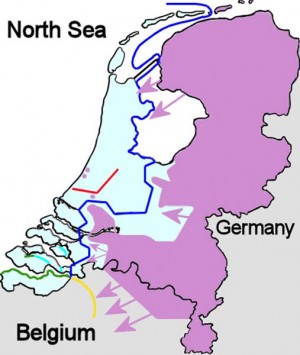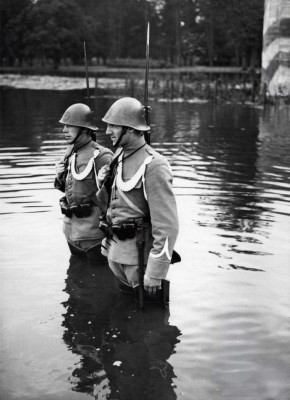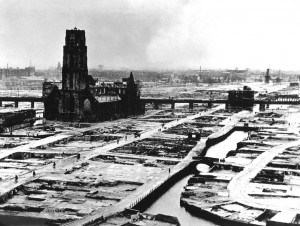 The Battle of Netherlands was part of a German military operation dubbed Fall Gelb through which Hitler conquered the Netherlands, Belgium, and Luxembourg. During World War II, seizing these lands ensured that Germany would have a buffer zone against Britain and France. Historical records state that it took the German defense forces a period of about seven days (from May 10 to May 17, 1940) to occupy all key cities of the Netherlands.
The Battle of Netherlands was part of a German military operation dubbed Fall Gelb through which Hitler conquered the Netherlands, Belgium, and Luxembourg. During World War II, seizing these lands ensured that Germany would have a buffer zone against Britain and France. Historical records state that it took the German defense forces a period of about seven days (from May 10 to May 17, 1940) to occupy all key cities of the Netherlands.
The War Starts
The Battle of the Netherlands technically started in 1939 when Netherlands was under the rule of Prime Minister Hendrikus Colijin. German forces had invaded Poland – a move which Britain and France were not comfortable with. Subsequently, the two countries had declared war against Hitler.
Following this was a period of tension between the two sides known as the Phoney War Period. During this period, the UK and the French equipped their army in readiness for a long period of war as Hitler completed his conquest of Poland.
Dutch Neutrality
In the meantime, the Netherlands under the leadership of Hendrikus Colijin maintained a neutral stance. It viewed Germany as one of its strategic trade partners and did not want to destroy its mutual trade through war.
The Dutch government tended to avoid fuelling rivalry with the Germans even to the point of repressing criticism of controversial Nazi policies. The Dutch economy was not performing well and so strict budgetary limits were imposed on the department of defense. This meant that the Netherlands as a territory was very vulnerable to attack.
Germany wanted to protect one of its vital regions, the Ruhr Area, against attacks by the Allied forces and the only way to minimize threats of unanticipated attacks was to invade the Lower countries, Netherlands included.
As international tensions grew, the Netherlands hoped to maintain a neutral stance as they had done during the 1st world war twenty five years earlier. To ensure this impartiality, the Netherlands army was mobilized and entrenched. It is claimed that at one point they ordered some military equipment from Germany, which for obvious reasons delayed the deliveries.
The Low Countries Targeted
The three countries known as the Low Countries were strategically located between France and Germany, making them a logical route for either of the two enemies to launch an offensive. In a radio speech, Winston Churchill addressed their governments, urging them to secure their borders against imminent attacks by the Germans. However, they ignored this advice, choosing to retain their middle ground stance in the conflict as they had done in the past.
The Dutch Army
 The Dutch army had not expanded much since the First World War. Its lack of a sufficiently trained manpower base meant that they were ill prepared for any form of attack.
The Dutch army had not expanded much since the First World War. Its lack of a sufficiently trained manpower base meant that they were ill prepared for any form of attack.
There were just eight infantry divisions and just enough artillery equipment for the larger units. In total, the Dutch forces consisted of 22 infantry battalions and 48 regiments for strategic border defense. Its fellow middle-ground ally, Belgium, had only 22 regiments and 30 infantry battalions.
In late 1939, efforts were made to strengthen the force but due to delays on the supplier side very little progress was made. On the 10th of May in 1940, the force was clearly in shortage of armor and had poor telecommunication devices despite Netherlands being the seat of Phillips.
The Air Division
The Air Force division of the Dutch force was a department of the larger army and it only had 155 aircrafts. Another forty aircrafts served the naval force. It is argued that the full potential of the Dutch air military power was under-exploited due to budget limitations.
Some historical accounts claim that the Dutch defense force was not only underequipped but also undertrained. Individual soldiers lacked many of the necessary war skills. By 1940 only 1,206 professional military officers were present in the army.
It is said that Hitler and his tacticians had a low opinion of the Netherlands military and expected to take over the core areas of the country in no more than 5 days.
The Battle
 The battle started on the early hours of May 10, 1940 when the Germans commenced operation Fall Gelb taking the Lower Countries by surprise. German military choppers made their way into the Dutch airspace engaging in numerous bombardments before landing in various airfields. A scheduled attack of The Hague at first seemed to end in failure when the forces failed to capture strategic areas of the city. Meanwhile, by the evening of the same day, the French forces had started arriving on the Dutch border in readiness for battle.
The battle started on the early hours of May 10, 1940 when the Germans commenced operation Fall Gelb taking the Lower Countries by surprise. German military choppers made their way into the Dutch airspace engaging in numerous bombardments before landing in various airfields. A scheduled attack of The Hague at first seemed to end in failure when the forces failed to capture strategic areas of the city. Meanwhile, by the evening of the same day, the French forces had started arriving on the Dutch border in readiness for battle.
Days after the invasion of the Netherlands by the Germans, the Dutch forces surrendered, leaving the Germans with control of all the key areas of the country.
Defeated
The Battle ended soon after devastating bombings by the German Luftwaffe in Rotterdam, paralyzing all military and economic reins held by the Dutch Government. Subsequent threats to bomb more cities in the Netherlands might have led to the surrender of the Dutch forces. Following this invasion, the Dutch government established a government-in-exile in Britain.
The Netherlands remained under the rule of the Germans for five years until 1945 when the last of its territory was liberated by the Allied forces. Historical records state that about 300,000 Dutchmen died as prisoners during the German invasion and occupation.